Assessment of Qualitative Characteristics of Financial Information
VerifiedAdded on 2020/04/01
|9
|1801
|51
Report
AI Summary
This report delves into the qualitative characteristics of financial information, as defined by the Australian Accounting Standard Board, emphasizing their importance in financial reporting. The report categorizes these characteristics into two key areas: selection criteria (relevance and reliability) and presentation criteria (comparability and understandability). It explains the significance of relevance in influencing user decisions through predictive and confirmatory values, while also stressing the need for reliable information that accurately reflects business transactions. The report further discusses the materiality test, which assesses the significance of information in decision-making. Comparability, allowing for analysis across time periods and entities, and understandability, ensuring clear presentation, are also highlighted as crucial components. The conclusion reinforces the necessity of these characteristics, alongside timeliness, to provide valuable financial reports for various purposes, including regulatory compliance and loan applications. The report also references various sources to support its claims.
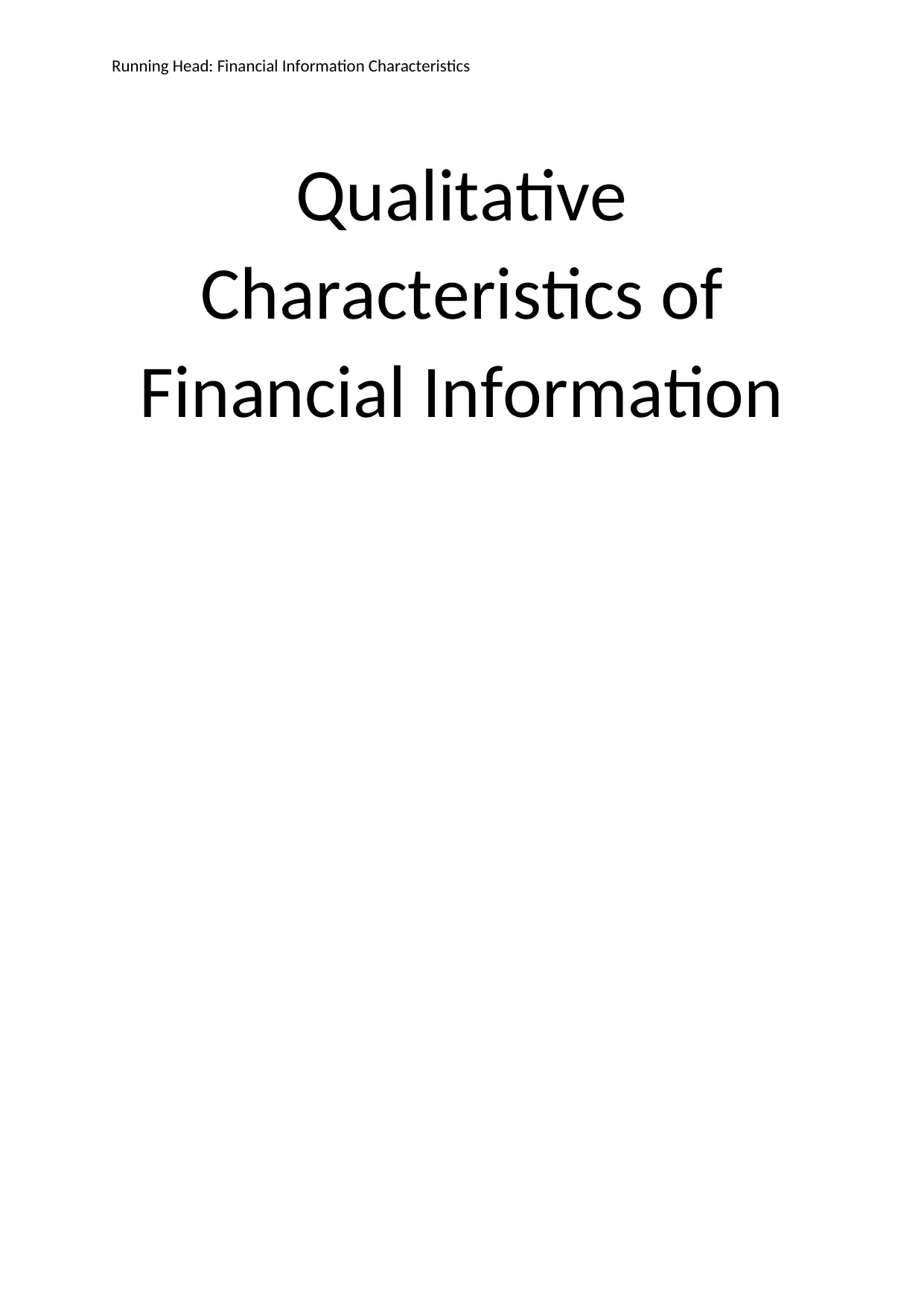
Running Head: Financial Information Characteristics
Qualitative
Characteristics of
Financial Information
Qualitative
Characteristics of
Financial Information
Paraphrase This Document
Need a fresh take? Get an instant paraphrase of this document with our AI Paraphraser
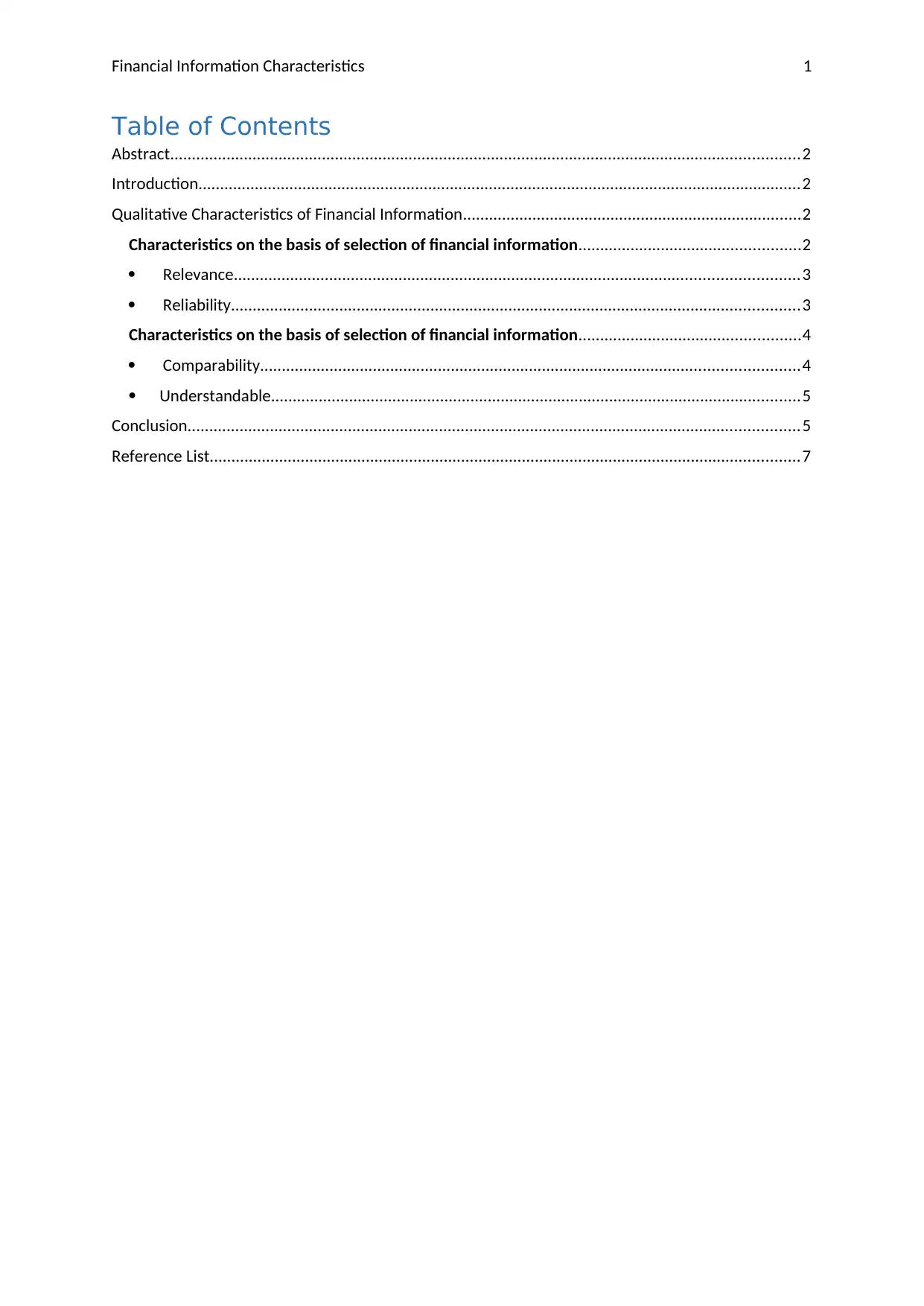
Financial Information Characteristics 1
Table of Contents
Abstract.................................................................................................................................................2
Introduction...........................................................................................................................................2
Qualitative Characteristics of Financial Information..............................................................................2
Characteristics on the basis of selection of financial information...................................................2
Relevance..................................................................................................................................3
Reliability...................................................................................................................................3
Characteristics on the basis of selection of financial information...................................................4
Comparability............................................................................................................................4
Understandable..........................................................................................................................5
Conclusion.............................................................................................................................................5
Reference List........................................................................................................................................7
Table of Contents
Abstract.................................................................................................................................................2
Introduction...........................................................................................................................................2
Qualitative Characteristics of Financial Information..............................................................................2
Characteristics on the basis of selection of financial information...................................................2
Relevance..................................................................................................................................3
Reliability...................................................................................................................................3
Characteristics on the basis of selection of financial information...................................................4
Comparability............................................................................................................................4
Understandable..........................................................................................................................5
Conclusion.............................................................................................................................................5
Reference List........................................................................................................................................7
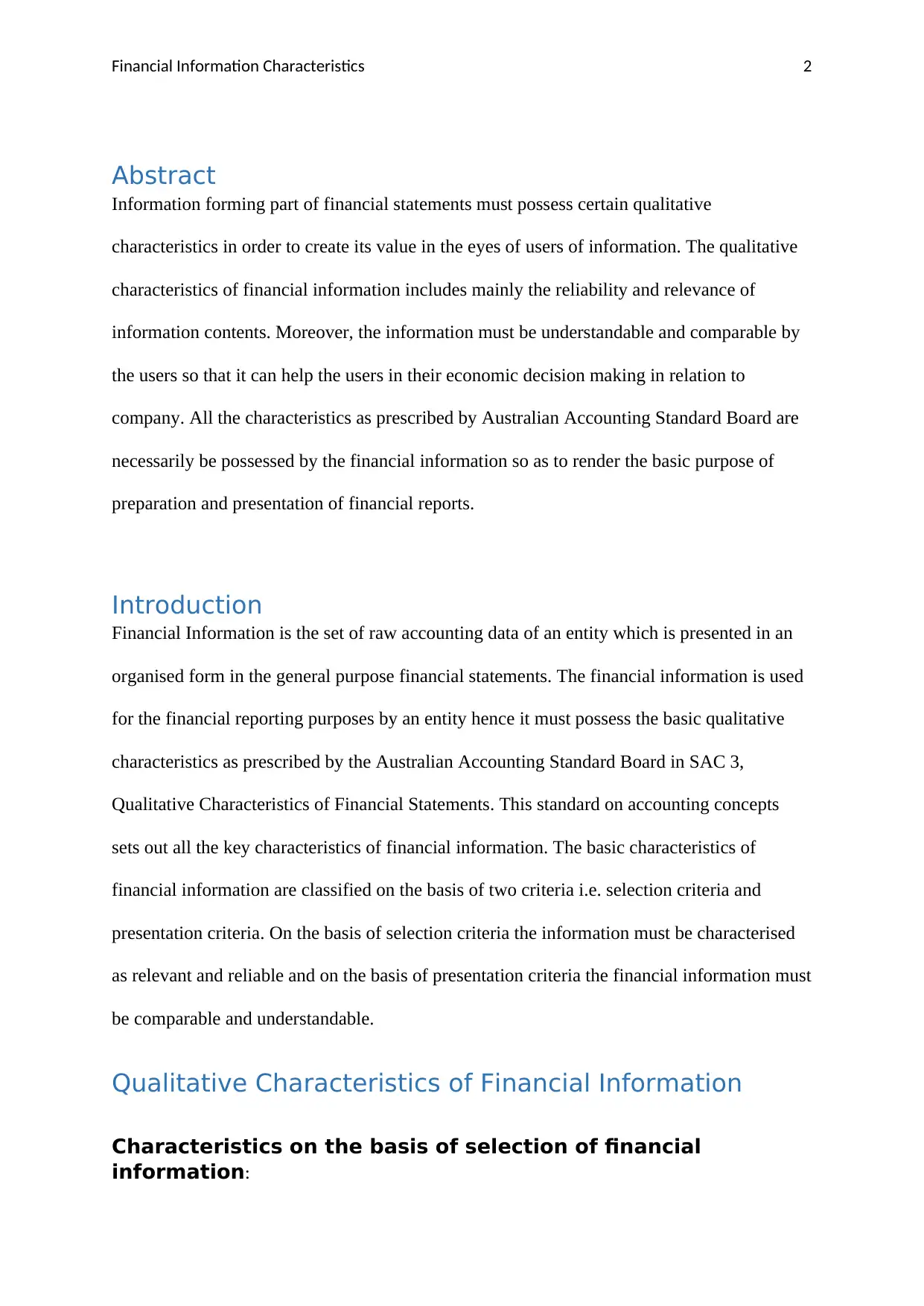
Financial Information Characteristics 2
Abstract
Information forming part of financial statements must possess certain qualitative
characteristics in order to create its value in the eyes of users of information. The qualitative
characteristics of financial information includes mainly the reliability and relevance of
information contents. Moreover, the information must be understandable and comparable by
the users so that it can help the users in their economic decision making in relation to
company. All the characteristics as prescribed by Australian Accounting Standard Board are
necessarily be possessed by the financial information so as to render the basic purpose of
preparation and presentation of financial reports.
Introduction
Financial Information is the set of raw accounting data of an entity which is presented in an
organised form in the general purpose financial statements. The financial information is used
for the financial reporting purposes by an entity hence it must possess the basic qualitative
characteristics as prescribed by the Australian Accounting Standard Board in SAC 3,
Qualitative Characteristics of Financial Statements. This standard on accounting concepts
sets out all the key characteristics of financial information. The basic characteristics of
financial information are classified on the basis of two criteria i.e. selection criteria and
presentation criteria. On the basis of selection criteria the information must be characterised
as relevant and reliable and on the basis of presentation criteria the financial information must
be comparable and understandable.
Qualitative Characteristics of Financial Information
Characteristics on the basis of selection of financial
information:
Abstract
Information forming part of financial statements must possess certain qualitative
characteristics in order to create its value in the eyes of users of information. The qualitative
characteristics of financial information includes mainly the reliability and relevance of
information contents. Moreover, the information must be understandable and comparable by
the users so that it can help the users in their economic decision making in relation to
company. All the characteristics as prescribed by Australian Accounting Standard Board are
necessarily be possessed by the financial information so as to render the basic purpose of
preparation and presentation of financial reports.
Introduction
Financial Information is the set of raw accounting data of an entity which is presented in an
organised form in the general purpose financial statements. The financial information is used
for the financial reporting purposes by an entity hence it must possess the basic qualitative
characteristics as prescribed by the Australian Accounting Standard Board in SAC 3,
Qualitative Characteristics of Financial Statements. This standard on accounting concepts
sets out all the key characteristics of financial information. The basic characteristics of
financial information are classified on the basis of two criteria i.e. selection criteria and
presentation criteria. On the basis of selection criteria the information must be characterised
as relevant and reliable and on the basis of presentation criteria the financial information must
be comparable and understandable.
Qualitative Characteristics of Financial Information
Characteristics on the basis of selection of financial
information:
⊘ This is a preview!⊘
Do you want full access?
Subscribe today to unlock all pages.

Trusted by 1+ million students worldwide
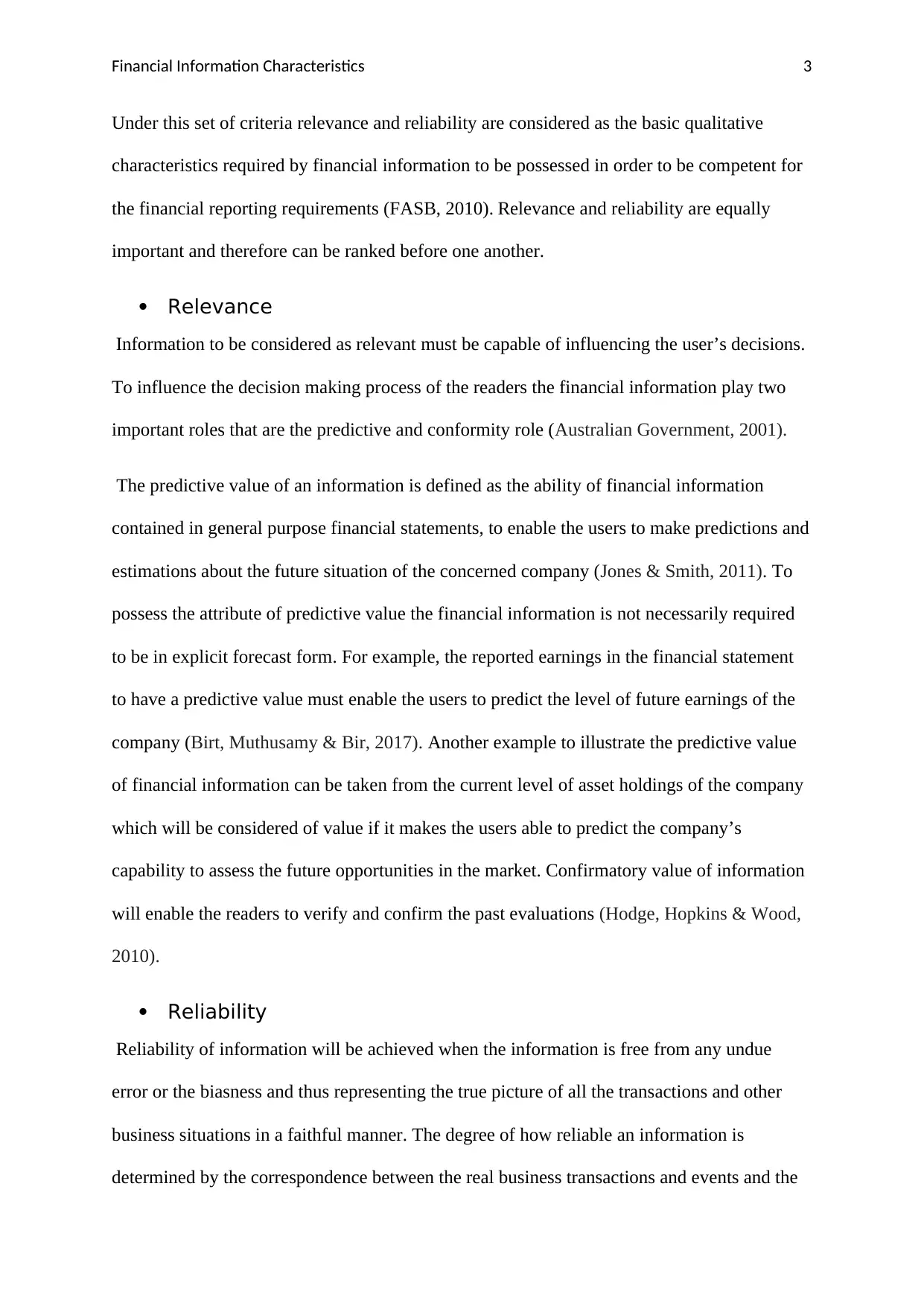
Financial Information Characteristics 3
Under this set of criteria relevance and reliability are considered as the basic qualitative
characteristics required by financial information to be possessed in order to be competent for
the financial reporting requirements (FASB, 2010). Relevance and reliability are equally
important and therefore can be ranked before one another.
Relevance
Information to be considered as relevant must be capable of influencing the user’s decisions.
To influence the decision making process of the readers the financial information play two
important roles that are the predictive and conformity role (Australian Government, 2001).
The predictive value of an information is defined as the ability of financial information
contained in general purpose financial statements, to enable the users to make predictions and
estimations about the future situation of the concerned company (Jones & Smith, 2011). To
possess the attribute of predictive value the financial information is not necessarily required
to be in explicit forecast form. For example, the reported earnings in the financial statement
to have a predictive value must enable the users to predict the level of future earnings of the
company (Birt, Muthusamy & Bir, 2017). Another example to illustrate the predictive value
of financial information can be taken from the current level of asset holdings of the company
which will be considered of value if it makes the users able to predict the company’s
capability to assess the future opportunities in the market. Confirmatory value of information
will enable the readers to verify and confirm the past evaluations (Hodge, Hopkins & Wood,
2010).
Reliability
Reliability of information will be achieved when the information is free from any undue
error or the biasness and thus representing the true picture of all the transactions and other
business situations in a faithful manner. The degree of how reliable an information is
determined by the correspondence between the real business transactions and events and the
Under this set of criteria relevance and reliability are considered as the basic qualitative
characteristics required by financial information to be possessed in order to be competent for
the financial reporting requirements (FASB, 2010). Relevance and reliability are equally
important and therefore can be ranked before one another.
Relevance
Information to be considered as relevant must be capable of influencing the user’s decisions.
To influence the decision making process of the readers the financial information play two
important roles that are the predictive and conformity role (Australian Government, 2001).
The predictive value of an information is defined as the ability of financial information
contained in general purpose financial statements, to enable the users to make predictions and
estimations about the future situation of the concerned company (Jones & Smith, 2011). To
possess the attribute of predictive value the financial information is not necessarily required
to be in explicit forecast form. For example, the reported earnings in the financial statement
to have a predictive value must enable the users to predict the level of future earnings of the
company (Birt, Muthusamy & Bir, 2017). Another example to illustrate the predictive value
of financial information can be taken from the current level of asset holdings of the company
which will be considered of value if it makes the users able to predict the company’s
capability to assess the future opportunities in the market. Confirmatory value of information
will enable the readers to verify and confirm the past evaluations (Hodge, Hopkins & Wood,
2010).
Reliability
Reliability of information will be achieved when the information is free from any undue
error or the biasness and thus representing the true picture of all the transactions and other
business situations in a faithful manner. The degree of how reliable an information is
determined by the correspondence between the real business transactions and events and the
Paraphrase This Document
Need a fresh take? Get an instant paraphrase of this document with our AI Paraphraser
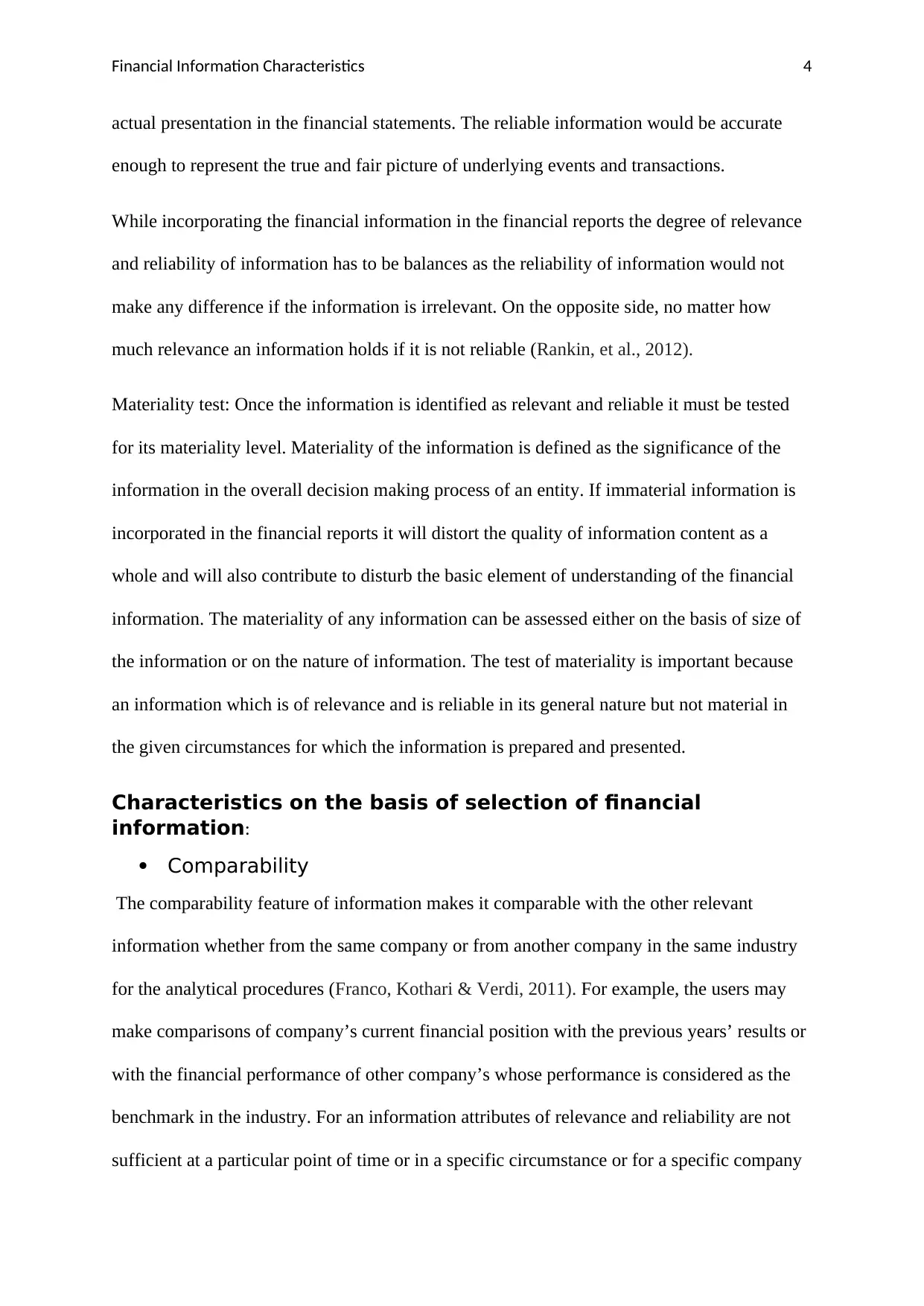
Financial Information Characteristics 4
actual presentation in the financial statements. The reliable information would be accurate
enough to represent the true and fair picture of underlying events and transactions.
While incorporating the financial information in the financial reports the degree of relevance
and reliability of information has to be balances as the reliability of information would not
make any difference if the information is irrelevant. On the opposite side, no matter how
much relevance an information holds if it is not reliable (Rankin, et al., 2012).
Materiality test: Once the information is identified as relevant and reliable it must be tested
for its materiality level. Materiality of the information is defined as the significance of the
information in the overall decision making process of an entity. If immaterial information is
incorporated in the financial reports it will distort the quality of information content as a
whole and will also contribute to disturb the basic element of understanding of the financial
information. The materiality of any information can be assessed either on the basis of size of
the information or on the nature of information. The test of materiality is important because
an information which is of relevance and is reliable in its general nature but not material in
the given circumstances for which the information is prepared and presented.
Characteristics on the basis of selection of financial
information:
Comparability
The comparability feature of information makes it comparable with the other relevant
information whether from the same company or from another company in the same industry
for the analytical procedures (Franco, Kothari & Verdi, 2011). For example, the users may
make comparisons of company’s current financial position with the previous years’ results or
with the financial performance of other company’s whose performance is considered as the
benchmark in the industry. For an information attributes of relevance and reliability are not
sufficient at a particular point of time or in a specific circumstance or for a specific company
actual presentation in the financial statements. The reliable information would be accurate
enough to represent the true and fair picture of underlying events and transactions.
While incorporating the financial information in the financial reports the degree of relevance
and reliability of information has to be balances as the reliability of information would not
make any difference if the information is irrelevant. On the opposite side, no matter how
much relevance an information holds if it is not reliable (Rankin, et al., 2012).
Materiality test: Once the information is identified as relevant and reliable it must be tested
for its materiality level. Materiality of the information is defined as the significance of the
information in the overall decision making process of an entity. If immaterial information is
incorporated in the financial reports it will distort the quality of information content as a
whole and will also contribute to disturb the basic element of understanding of the financial
information. The materiality of any information can be assessed either on the basis of size of
the information or on the nature of information. The test of materiality is important because
an information which is of relevance and is reliable in its general nature but not material in
the given circumstances for which the information is prepared and presented.
Characteristics on the basis of selection of financial
information:
Comparability
The comparability feature of information makes it comparable with the other relevant
information whether from the same company or from another company in the same industry
for the analytical procedures (Franco, Kothari & Verdi, 2011). For example, the users may
make comparisons of company’s current financial position with the previous years’ results or
with the financial performance of other company’s whose performance is considered as the
benchmark in the industry. For an information attributes of relevance and reliability are not
sufficient at a particular point of time or in a specific circumstance or for a specific company
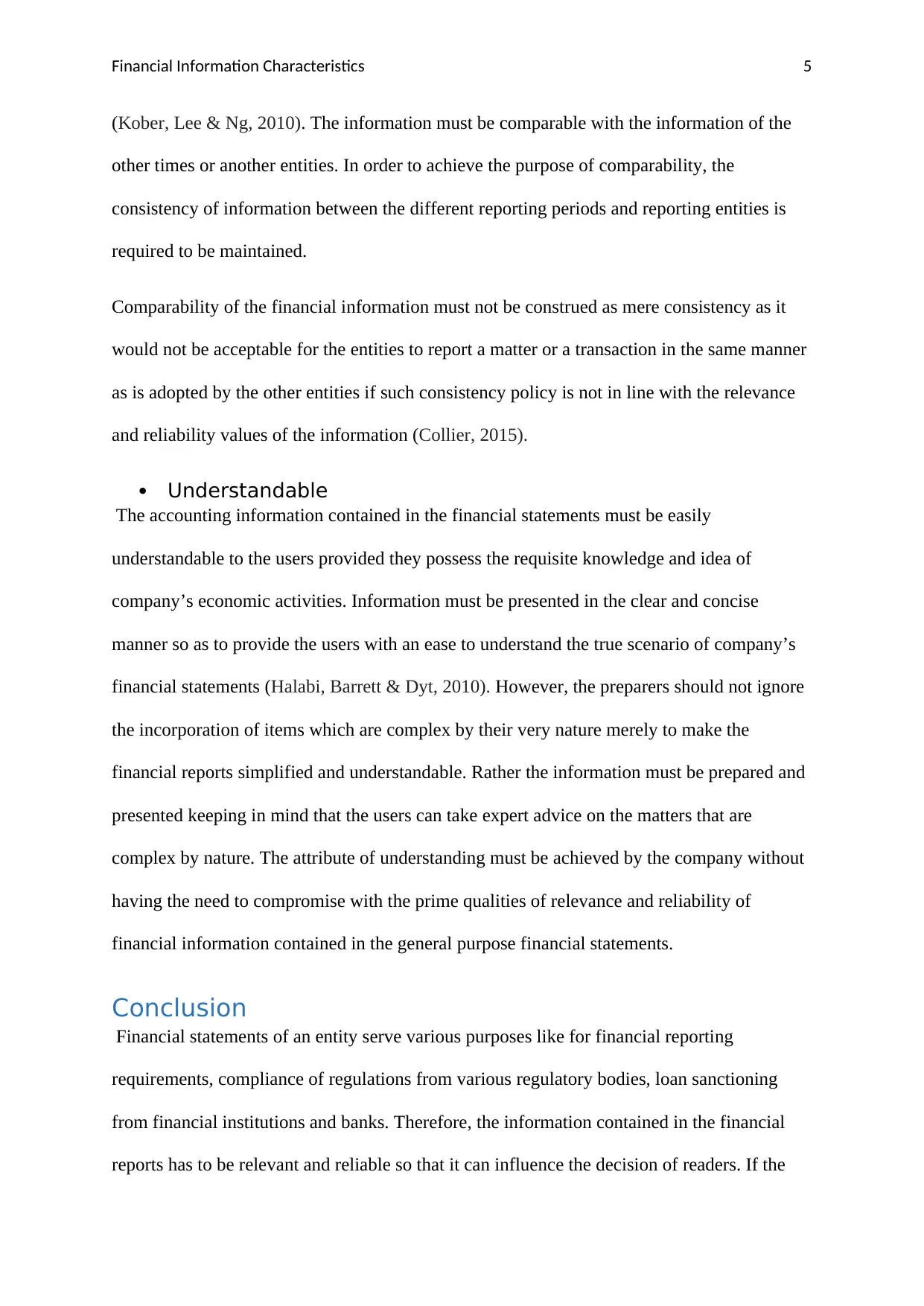
Financial Information Characteristics 5
(Kober, Lee & Ng, 2010). The information must be comparable with the information of the
other times or another entities. In order to achieve the purpose of comparability, the
consistency of information between the different reporting periods and reporting entities is
required to be maintained.
Comparability of the financial information must not be construed as mere consistency as it
would not be acceptable for the entities to report a matter or a transaction in the same manner
as is adopted by the other entities if such consistency policy is not in line with the relevance
and reliability values of the information (Collier, 2015).
Understandable
The accounting information contained in the financial statements must be easily
understandable to the users provided they possess the requisite knowledge and idea of
company’s economic activities. Information must be presented in the clear and concise
manner so as to provide the users with an ease to understand the true scenario of company’s
financial statements (Halabi, Barrett & Dyt, 2010). However, the preparers should not ignore
the incorporation of items which are complex by their very nature merely to make the
financial reports simplified and understandable. Rather the information must be prepared and
presented keeping in mind that the users can take expert advice on the matters that are
complex by nature. The attribute of understanding must be achieved by the company without
having the need to compromise with the prime qualities of relevance and reliability of
financial information contained in the general purpose financial statements.
Conclusion
Financial statements of an entity serve various purposes like for financial reporting
requirements, compliance of regulations from various regulatory bodies, loan sanctioning
from financial institutions and banks. Therefore, the information contained in the financial
reports has to be relevant and reliable so that it can influence the decision of readers. If the
(Kober, Lee & Ng, 2010). The information must be comparable with the information of the
other times or another entities. In order to achieve the purpose of comparability, the
consistency of information between the different reporting periods and reporting entities is
required to be maintained.
Comparability of the financial information must not be construed as mere consistency as it
would not be acceptable for the entities to report a matter or a transaction in the same manner
as is adopted by the other entities if such consistency policy is not in line with the relevance
and reliability values of the information (Collier, 2015).
Understandable
The accounting information contained in the financial statements must be easily
understandable to the users provided they possess the requisite knowledge and idea of
company’s economic activities. Information must be presented in the clear and concise
manner so as to provide the users with an ease to understand the true scenario of company’s
financial statements (Halabi, Barrett & Dyt, 2010). However, the preparers should not ignore
the incorporation of items which are complex by their very nature merely to make the
financial reports simplified and understandable. Rather the information must be prepared and
presented keeping in mind that the users can take expert advice on the matters that are
complex by nature. The attribute of understanding must be achieved by the company without
having the need to compromise with the prime qualities of relevance and reliability of
financial information contained in the general purpose financial statements.
Conclusion
Financial statements of an entity serve various purposes like for financial reporting
requirements, compliance of regulations from various regulatory bodies, loan sanctioning
from financial institutions and banks. Therefore, the information contained in the financial
reports has to be relevant and reliable so that it can influence the decision of readers. If the
⊘ This is a preview!⊘
Do you want full access?
Subscribe today to unlock all pages.

Trusted by 1+ million students worldwide

Financial Information Characteristics 6
preparers of the information neglects the importance of the qualitative characteristics of the
information, the information will lose its value in the eyes of users. Besides the key
qualitative characteristics, timeliness of the information has to be given due importance. An
information provided on time only can have its value for the users in their decision making
otherwise it is of no use or relevance. Therefore to provide the best outcomes of the reports
the information content must possess all the above discussed attributes.
preparers of the information neglects the importance of the qualitative characteristics of the
information, the information will lose its value in the eyes of users. Besides the key
qualitative characteristics, timeliness of the information has to be given due importance. An
information provided on time only can have its value for the users in their decision making
otherwise it is of no use or relevance. Therefore to provide the best outcomes of the reports
the information content must possess all the above discussed attributes.
Paraphrase This Document
Need a fresh take? Get an instant paraphrase of this document with our AI Paraphraser
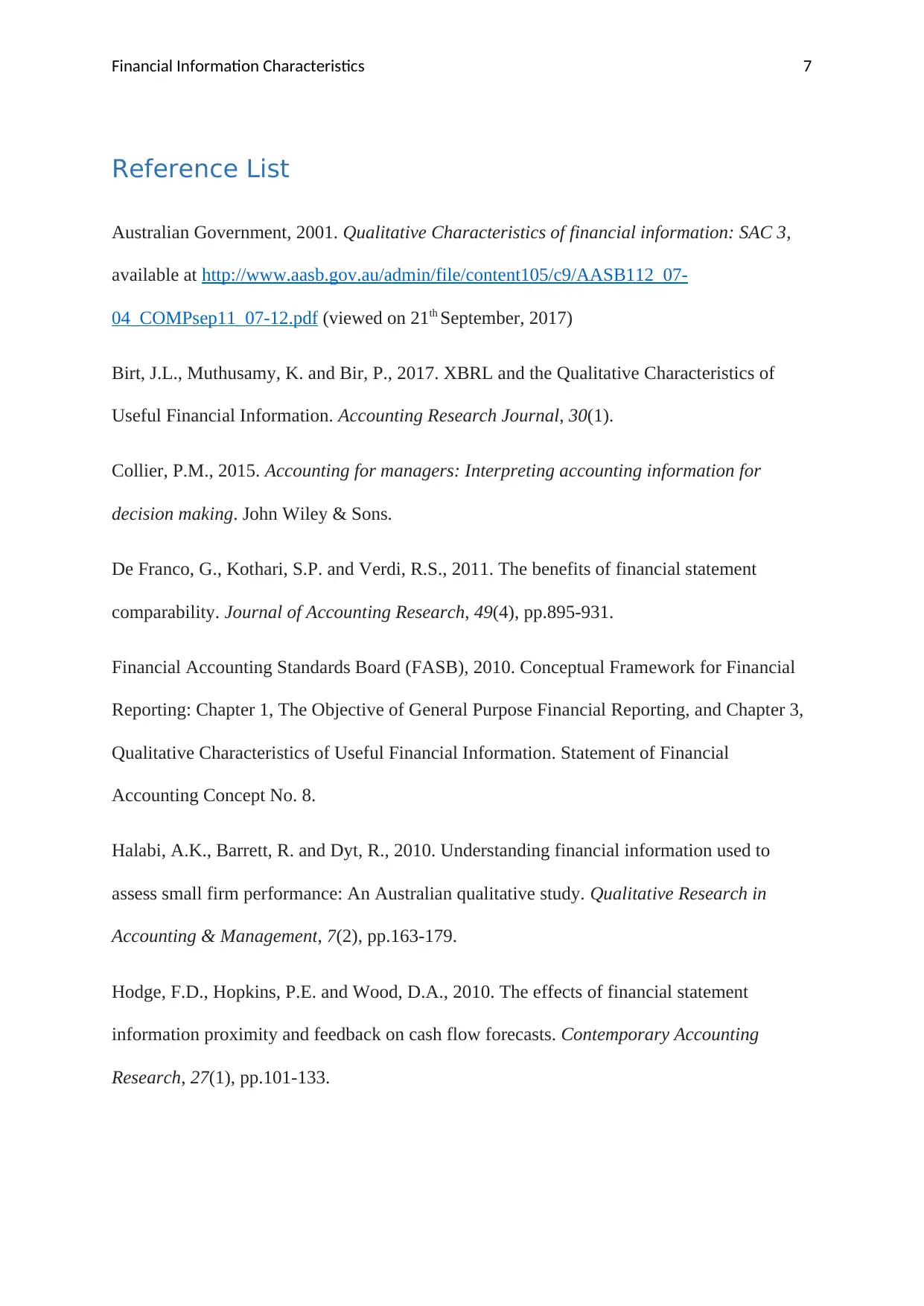
Financial Information Characteristics 7
Reference List
Australian Government, 2001. Qualitative Characteristics of financial information: SAC 3,
available at http://www.aasb.gov.au/admin/file/content105/c9/AASB112_07-
04_COMPsep11_07-12.pdf (viewed on 21th September, 2017)
Birt, J.L., Muthusamy, K. and Bir, P., 2017. XBRL and the Qualitative Characteristics of
Useful Financial Information. Accounting Research Journal, 30(1).
Collier, P.M., 2015. Accounting for managers: Interpreting accounting information for
decision making. John Wiley & Sons.
De Franco, G., Kothari, S.P. and Verdi, R.S., 2011. The benefits of financial statement
comparability. Journal of Accounting Research, 49(4), pp.895-931.
Financial Accounting Standards Board (FASB), 2010. Conceptual Framework for Financial
Reporting: Chapter 1, The Objective of General Purpose Financial Reporting, and Chapter 3,
Qualitative Characteristics of Useful Financial Information. Statement of Financial
Accounting Concept No. 8.
Halabi, A.K., Barrett, R. and Dyt, R., 2010. Understanding financial information used to
assess small firm performance: An Australian qualitative study. Qualitative Research in
Accounting & Management, 7(2), pp.163-179.
Hodge, F.D., Hopkins, P.E. and Wood, D.A., 2010. The effects of financial statement
information proximity and feedback on cash flow forecasts. Contemporary Accounting
Research, 27(1), pp.101-133.
Reference List
Australian Government, 2001. Qualitative Characteristics of financial information: SAC 3,
available at http://www.aasb.gov.au/admin/file/content105/c9/AASB112_07-
04_COMPsep11_07-12.pdf (viewed on 21th September, 2017)
Birt, J.L., Muthusamy, K. and Bir, P., 2017. XBRL and the Qualitative Characteristics of
Useful Financial Information. Accounting Research Journal, 30(1).
Collier, P.M., 2015. Accounting for managers: Interpreting accounting information for
decision making. John Wiley & Sons.
De Franco, G., Kothari, S.P. and Verdi, R.S., 2011. The benefits of financial statement
comparability. Journal of Accounting Research, 49(4), pp.895-931.
Financial Accounting Standards Board (FASB), 2010. Conceptual Framework for Financial
Reporting: Chapter 1, The Objective of General Purpose Financial Reporting, and Chapter 3,
Qualitative Characteristics of Useful Financial Information. Statement of Financial
Accounting Concept No. 8.
Halabi, A.K., Barrett, R. and Dyt, R., 2010. Understanding financial information used to
assess small firm performance: An Australian qualitative study. Qualitative Research in
Accounting & Management, 7(2), pp.163-179.
Hodge, F.D., Hopkins, P.E. and Wood, D.A., 2010. The effects of financial statement
information proximity and feedback on cash flow forecasts. Contemporary Accounting
Research, 27(1), pp.101-133.
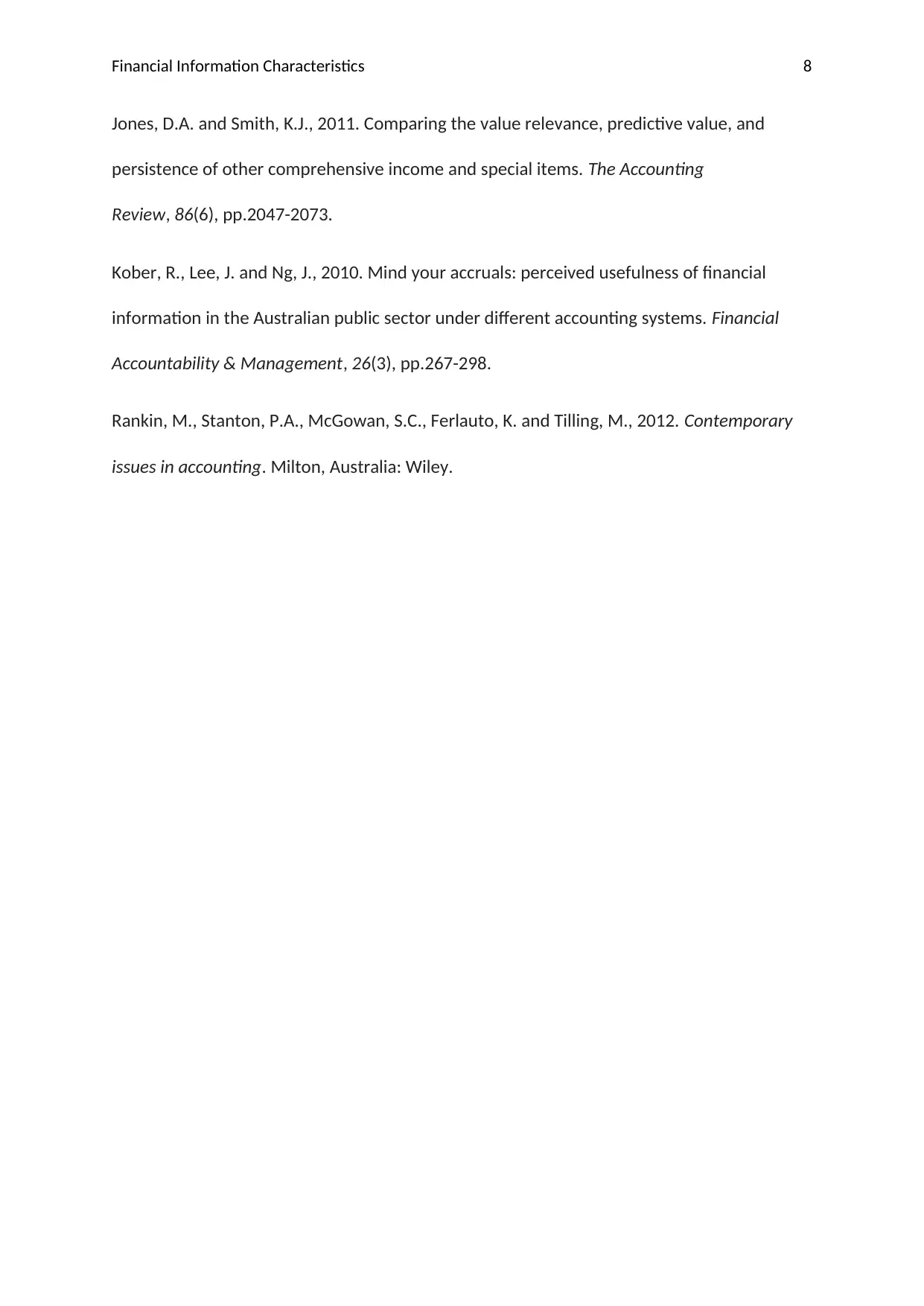
Financial Information Characteristics 8
Jones, D.A. and Smith, K.J., 2011. Comparing the value relevance, predictive value, and
persistence of other comprehensive income and special items. The Accounting
Review, 86(6), pp.2047-2073.
Kober, R., Lee, J. and Ng, J., 2010. Mind your accruals: perceived usefulness of financial
information in the Australian public sector under different accounting systems. Financial
Accountability & Management, 26(3), pp.267-298.
Rankin, M., Stanton, P.A., McGowan, S.C., Ferlauto, K. and Tilling, M., 2012. Contemporary
issues in accounting. Milton, Australia: Wiley.
Jones, D.A. and Smith, K.J., 2011. Comparing the value relevance, predictive value, and
persistence of other comprehensive income and special items. The Accounting
Review, 86(6), pp.2047-2073.
Kober, R., Lee, J. and Ng, J., 2010. Mind your accruals: perceived usefulness of financial
information in the Australian public sector under different accounting systems. Financial
Accountability & Management, 26(3), pp.267-298.
Rankin, M., Stanton, P.A., McGowan, S.C., Ferlauto, K. and Tilling, M., 2012. Contemporary
issues in accounting. Milton, Australia: Wiley.
⊘ This is a preview!⊘
Do you want full access?
Subscribe today to unlock all pages.

Trusted by 1+ million students worldwide
1 out of 9
Related Documents
Your All-in-One AI-Powered Toolkit for Academic Success.
+13062052269
info@desklib.com
Available 24*7 on WhatsApp / Email
![[object Object]](/_next/static/media/star-bottom.7253800d.svg)
Unlock your academic potential
Copyright © 2020–2025 A2Z Services. All Rights Reserved. Developed and managed by ZUCOL.





